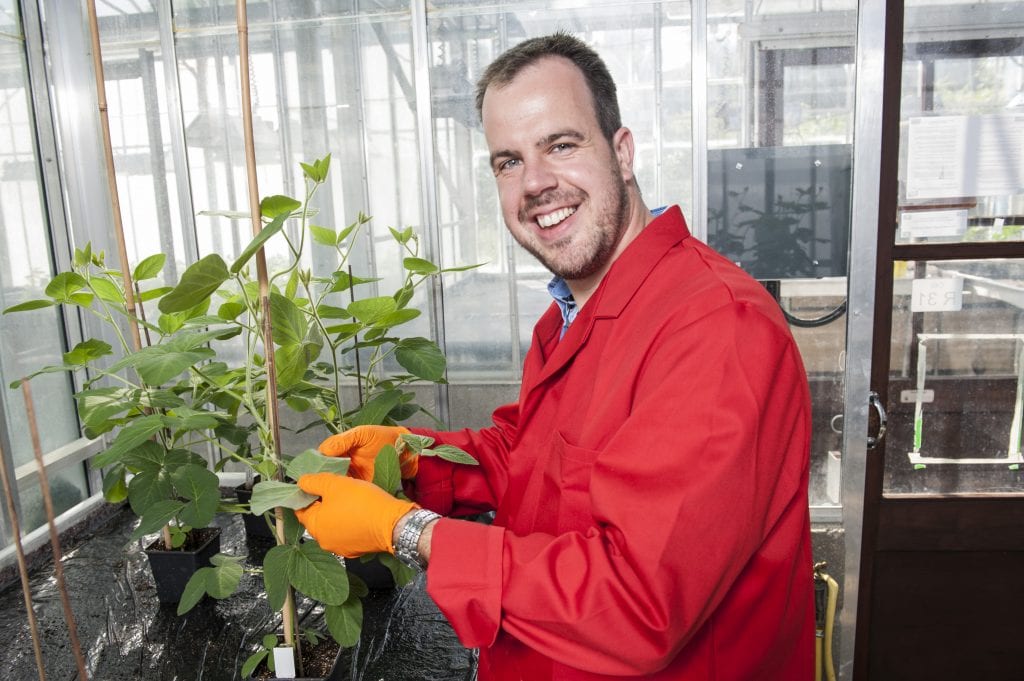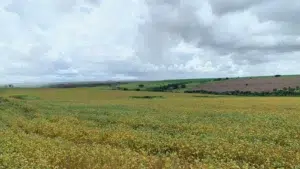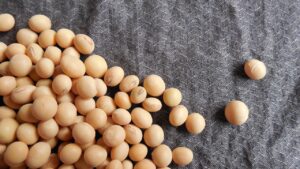Scientists have sequenced the Asian soybean rust genome, but what does that mean for the seed industry?
In September 2019, an international research collaboration announced it had successfully assembled a complete reference-quality genome sequence of Phakopsora pachyrhizi, the fungal pathogen that causes Asian soybean rust (ASR) which has a devastating impact on soybean production, an internationally important crop with 380 million tons produced globally. Soybean rust poses a threat to U.S. soybean production and is a crucial challenge for soybean growers around the world.
“Asian soybean rust is a significant challenge for soybean growers,” says Peter van Esse, leader of the 2Blades Group at The Sainsbury Laboratory, Norwich, one of the collaborators. “This reference level genome assembly will allow the scientific community to study, in unprecedented resolution, those components of the pathogen that are critical for causing disease. This is an essential first step toward the design of transformative control strategies to combat this highly damaging pathogen.”
High-quality, reference genomes are differentiated from draft genomes by their completeness (a low number of gaps), a low number of errors and a high percentage of sequences assembled into chromosomes. The fungus P. pachyrhizi has a large, complex genome. It is composed of 93% repetitive elements, a level of complexity that has delayed progress on the sequencing of this pathogen and required the latest in next-generation sequencing technologies to complete the task.
The international research consortium behind this effort includes 11 research and industry partners. In addition to The 2Blades Foundation and The Sainsbury Laboratory, participating partners include KeyGene, the Joint Genome Institute (JGI), Bayer AG, Syngenta AG, the Brazilian Company of Agricultural Research (Embrapa), l’Institut National de la Recherche Agronomique (INRA – France), the German Universities of Hohenheim and RWTH Aachen, and the Federal University of Viçosa (Brazil).
Genomic Surprises
Going into the project, researchers assumed they would be working with a fungus that had a small genome similar to other fungi with around 50 megabase-pairs (50 Mb). Very quickly, it became evident that P. pachyrhizi has a huge genome, perhaps as large as 1000 Mb, which is as much as 20 times larger than anticipated. That was the researchers’ first surprise. This information could imply a much larger gene complement in the soybean rust than in other rust fungi. So far, the numbers of genes reported in rust fungi are between 15,000 and 20,000 genes. Researchers’ second surprise was the type of genetic information contained in the genome.
“The pathogen’s genome is so big and so complex that no organization could individually complete the project. It was beyond our capability, so we decided to pool our resources and make everything publicly available,” explains van Esse. “The genome’s large size hampered progress until KeyGene provided its long-read, high-molecular-weight DNA-isolation protocol technology so that we could span those repetitive sequences and the genome assembly. By putting all the data of the partners together, we were able to assemble a high-quality genome and annotate the gene content from which we can learn a lot. All in all, this has been 10 years in the making. It is a long story of learning how complicated this genome is. It has taken our best bio-informaticians and biologists to bring this together.”
As genomic researchers initially encountered long blocks of repetitive, apparently undifferentiated DNA in plant and animal species, this material was early on considered nothing more than useless, junk material. Over time, however, a function could often be ascribed to this type of DNA. Similarly, van Esse and his colleagues are very interested in finding why P. pachyrhizi has such a large genome with an extreme amount of repetitive sequences.
“We believe that most of the genomic content has a function. In the case of the repetitive DNA, it may have something to do with the ability of the pathogen to adapt more rapidly to different conditions. The repetitive elements may enhance the fluidity of the genome to make adjustments that are necessary to survive,” van Esse says.

Opening Doors of Understanding
Finding genetic resistance in soybeans against this pathogen has been a huge challenge, partly because there are not many resistant soybean breeding lines that contain novel resistance in the first place. Van Esse says that to develop ASR resistance, researchers must begin with what is already known.
“We begin by using the best available data to identify molecules that we know are being used by the pathogen to cause disease. Plants, including soybean, have an excellent immune system that is dismantled and suppressed by ASR. We know pretty well from basic research how that works. Soybeans have an excellent self/non-self-recognition system, but ASR makes proteins called effectors and components that enable the pathogen to undermine soybean’s defense system. These effectors often disable soybean receptors that are a part of the non-self-detection system,” van Esse says. “Now that we have a complete catalog of all the proteins that are in the ASR genome, we can start to study those components that are used by the pathogen to suppress the soybean’s immune system.
“One way forward is to make a transgenic trait combining resistance genes from other legumes in a ‘stack’ which enables soybeans to recognize ASR. This novel recognition would tilt the balance in these new soybean plants’ favor. They would detect ASR again, switch on their immune system and take care of the invader. We already demonstrated that the principle is sound by transferring a receptor from Pigeon pea, a related legume species. However, given the pathogens adaptability, multiple genetic modes of action need to be combined to ensure a longer-term solution.”
Looking for Achilles’ Heel
Now that ASR’s genetic roadmap is known, the next step is to learn how this pathogen works and to find its Achilles’ heel. This could enable researchers to target the pathogen with a new combination of genetics, chemicals or other novel types of solutions. This new genomic information could help tremendously, even though some of these solutions may be reached years in the future.
“Some of the traits we are generating are still in the lab-phase, but I anticipate they will be available in the next decade,” van Esse predicts. “Some of the other things, like discovering the Achilles heel of the pathogen, is pure basic research. We don’t know whether that is an outcome anytime soon. We could have a major breakthrough tomorrow or in 20 years. However, in both cases, this genome is a critical component of solutions that are definitely coming.”
Plant breeders are working with the limited resistance present in soybeans. How well these resistances will work together is difficult to understand without understanding the underlying mechanism and how it relates to the pathogen.
“One of the big difficulties for breeders is that they need to combine multiple resistance gene traits,” van Esse explains. “Say a breeder wants to introduce three different sources of resistance from non-domesticated germplasm. All these resistances will be introduced into different places in the genome making tracking difficult. Also, other genes from the non-domesticated germplasm that often result in undesirable traits will be carried over. That is an enormous challenge for a single pathogen, especially if you are also trying to accomplish other things as well, such as simultaneously improving yields. You want to have a high yield and a beautiful crop that is resistant to key pathogens. Ideally, there is one place in the genome of a breeding line where multiple resistances are located. The nice thing about having a transgenic trait with, for example, three or more resistance genes together is that breeders have all the pathogen resistance they need in a single location,” he says. “That way researchers can easily track this resistance with molecular markers. That would be important for breeders because they could just follow this one trait. An added advantage is that this approach would not cause linkage drag.”
These transgenic stacks are, by themselves, of limited value, but their elegance is that once they are introduced into an initial breeding line, they can easily be moved into different maturity groups of different soybean cultivars. Until now, this has been the main reason why plant pathogens are such a challenge for breeders. Any plant pathogen will require several resistance genes to be combined without linkage drag. That is incredibly difficult to achieve.
“Breeders have done an impressive job so far,” van Esse says. “However, when a new disease or virulent isolate becomes an issue, they cannot breed in novel resistance without breaking up previously combined resistances. They have to start all over to develop new combinations. The dream is that you have most of your disease resistance in one or two loci.”
The ultimate, long-term potential for van Esse is to create a single resistance block to control ASR in soybeans. This resistance technology could significantly reduce the amount of fungicide farmers need to apply to produce a crop. In addition, growers would no longer be bound by a short fungicide application window to control this pathogen. Accomplishing these two things would be a huge victory.
“This type of technology might not be developed for other key crops due to current European Union regulations that prevent its use in Europe,” says van Esse. “Sensibly, in the United States, transgenic crops are permitted if they are determined by government scientists to be safe for human consumption and the environment. By 2050, we will need to produce twice as much food as we do now, and we must accomplish this with less land, water and chemicals. The reason we are in this business is because we care very deeply about the environment and about feeding everybody on the planet. We want to use the latest science to help develop safe, productive and nutritious crops to end hunger. That is why we come to work every day.”













